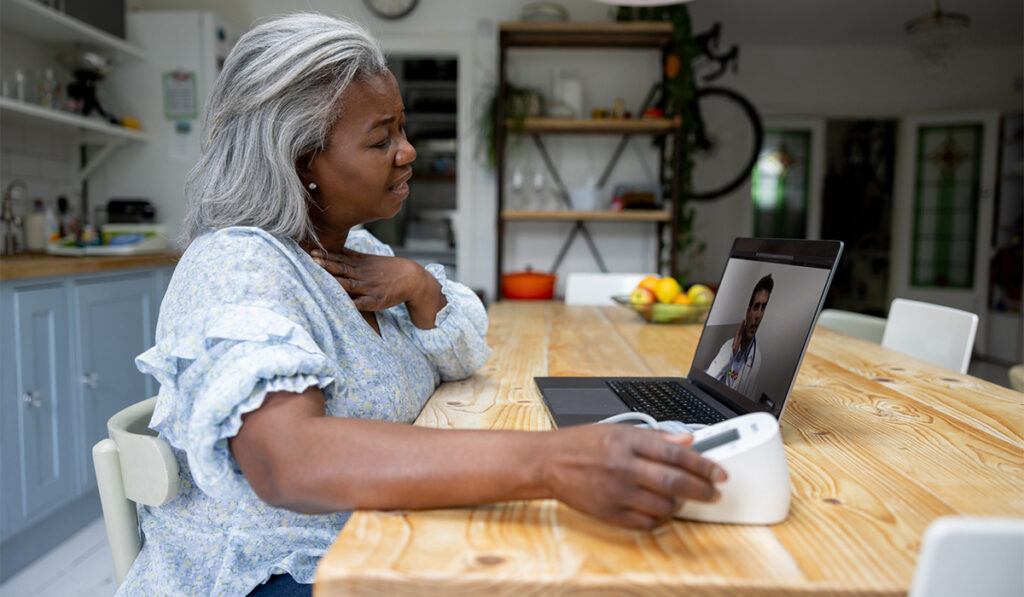Sara Horst, M.D., M.P.H., medical director for Telehealth Ambulatory Services at Vanderbilt University Medical Center, was pleased she and her research group had a head start on telehealth when the COVID-19 pandemic began.
In January 2020, Horst and her team had just launched a telehealth pilot program for inflammatory bowel disease. Motivated by a patient population requiring regular care for a chronic condition, with many driving great distances to the clinic in Nashville, Horst devised a way to make telehealth work for her patients.
“It was incredible to me to see an entire hospital system be able to pivot within two to three weeks to something that neither clinicians nor patients really had any experience with.”
Thus, when the pandemic hit, Horst was in a prime position to help her colleagues implement new telehealth programs.
“It was incredible to me to see an entire hospital system be able to pivot within two to three weeks to something that neither clinicians nor patients really had any experience with,” Horst said.
Lessons From the Pandemic
Horst learned quickly how to implement telehealth.
“The beginning stages of it actually looked quite different than what we’re doing now,” she said.
Horst and her team realized early that many patients had never participated in a video call, which made such calls challenging. At the same time, many medical students were stuck at home due to the pandemic feeling restless.
“We had a group of amazing medical students who really wanted to give back and try to help the organization,” Horst said.
Horst was determined to help patients succeed with telehealth. She and a team of three medical students organized more than 100 additional medical students to call patients and help them prepare for their telehealth visits.
They later published a review of their work in the Journal of Telemedicine and Telecare which shows a structured call to the patient in advance of a telehealth appointment is likely to increase the odds of a successful video visit.
With the shift in care affecting a large cohort of patients, Horst and her team were positioned to examine elements associated with outcomes of video visits.
The biggest factor in failed video visits identified so far is the area deprivation index, which is drawn from neighborhood-level socioeconomic data. The finding highlights the potential for social determinants of health to be considered for the success of telehealth visits.
Tips for Telehealth Success
For optimal telehealth, Horst recommends considering cases where the technology can be most useful. For patients with inflammatory bowel disease, for example, chronic disease management does not always require an in-person visit. Patients who live farther away from their doctor also stand to benefit from telehealth.
Another critical component of telehealth success is a video platform that is simple for patients and clinicians to use.
While Horst considers telehealth visits to be the equivalent of in-person visits, she emphasizes the importance of ensuring patients are on time for the start of the call and are in a setting that offers privacy and limited distractions. The ability to upload pictures is also helpful in some cases.
Other practical considerations involve letting the patient know who may be in the room with the provider and documenting the patient’s physical location.
Hospital systems will need to evolve to accommodate telehealth-related workflow, Horst believes.
She recommends providing lab orders through an online link that patients can download and bring to their lab of their choice, as well as setting up visit summaries and patient plans in the patient portal.
Future of Telehealth
“We are increasingly in a society where asynchronous care is happening,” Horst said, describing how information and directions for care are being exchanged by a patient and clinician at separate times of day via questionnaires and messaging.
“We are increasingly in a society where asynchronous care is happening.”
Other moves Horst thinks may be on the horizon include the use of “e-consults” occurring between individual clinicians and specialists, and greater use of remote patient monitoring for vital signs and other markers of health status.
Used in the correct context, telehealth can give patients all that a clinic visit provides while sparing them of the need to drive a long distance or take a day off work – and often the possibility of being seen sooner, Horst said.





